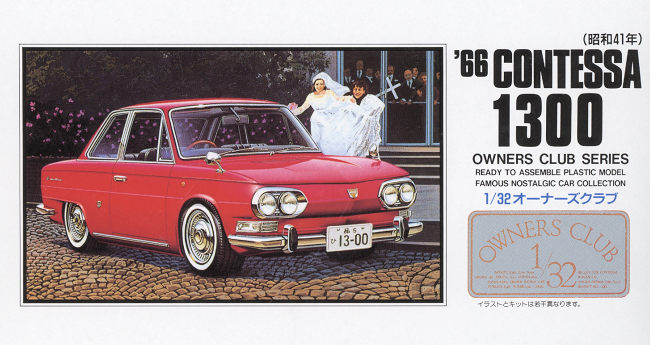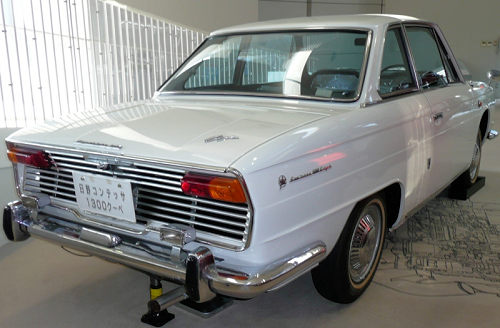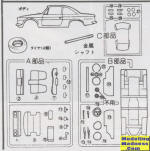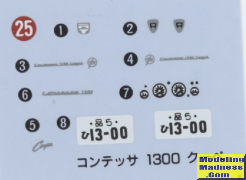
Arii 1/32 1966 Hino Contessa
| KIT #: | 01064 |
| PRICE: | 800 yen SRP |
| DECALS: | Plates, badges and instruments |
| REVIEWER: | Scott Van Aken |
| NOTES: | Curbside |

| HISTORY |
The Hino Contessa is an automobile which was produced by Hino Motors from 1961 to 1967.
The Contessa was developed largely from the 1947-1961 Renault 4CV powertrain under license to Hino Motors. Offered in both coupe and sedan bodystyles, it replaced the Hino Renault, which was the Renault 4CV manufactured by Hino for Japan. It was adapted into a small pickup truck called the Hino Briska, but used a front engine and rear drive powertrain, while the Contessa used a rear engine and rear drive setup. The PC series coupé was designed by Giovanni Michelotti, while the second generation was longer and wider in both coupé and sedan body styles.
Unlike many cars found internationally of this time period, using rear drive and rear engined powertrains, the Contessa was water-cooled rather than air-cooled. The name contessa is Italian for a countess.
 With
design by Giovanni Michelotti (who had sold a very similar design to Triumph for
their 1300), the second generation Contessa debuted in September 1964. While
considerably longer and heavier, the PD Contessa also had a much more powerful
1,251 cc four-cylinder engine with five main bearings ("GR100", 55 PS or 40 kW
or 54 hp). With a four-speed manual transmission, top speed is 130 km/h
(81 mph). A handsome coupé version was presented in April 1965; the coupé
benefitted from an upgraded engine with twin carburetors and slightly higher
compression and 65 PS (48 kW; 64 hp) from November of the same year. With
chassis code PD300/400 (versus PD100/200 for the regular sedan), this sporting
version was marketed as the "1300S". 100 and 300-series are right-hand drive,
while 200 and 400-series are left-hand drive. The use of twin headlights does
contribute to a mild similarity to the second generation Chevrolet Corvair, and
the lack of a front grille because the Contessa and the Corvair are both rear
engined and rear cooled (air for the Corvair, water for the Contessa). Early
Standard versions did not receive bumper horns and were fitted with single front
headlamps with blanks where the second set would have gone. Later on, the
Standard (of which very few survive) received the same headlamps and bumpers as
the De Luxe, albeit with painted rather than chromed bumpers.
With
design by Giovanni Michelotti (who had sold a very similar design to Triumph for
their 1300), the second generation Contessa debuted in September 1964. While
considerably longer and heavier, the PD Contessa also had a much more powerful
1,251 cc four-cylinder engine with five main bearings ("GR100", 55 PS or 40 kW
or 54 hp). With a four-speed manual transmission, top speed is 130 km/h
(81 mph). A handsome coupé version was presented in April 1965; the coupé
benefitted from an upgraded engine with twin carburetors and slightly higher
compression and 65 PS (48 kW; 64 hp) from November of the same year. With
chassis code PD300/400 (versus PD100/200 for the regular sedan), this sporting
version was marketed as the "1300S". 100 and 300-series are right-hand drive,
while 200 and 400-series are left-hand drive. The use of twin headlights does
contribute to a mild similarity to the second generation Chevrolet Corvair, and
the lack of a front grille because the Contessa and the Corvair are both rear
engined and rear cooled (air for the Corvair, water for the Contessa). Early
Standard versions did not receive bumper horns and were fitted with single front
headlamps with blanks where the second set would have gone. Later on, the
Standard (of which very few survive) received the same headlamps and bumpers as
the De Luxe, albeit with painted rather than chromed bumpers.
This generation of the Contessa was also exported, to Australia, Switzerland, and the Netherlands amongst others. As a part of this export drive, the Contessa also saw local assembly in New Zealand (by Campbell Motors, around 600 are thought to have been assembled there) and in Israel (by Autocars). 55,027 PD Contessas were built, of which 3,868 were Coupés
| THE KIT |
 This
is the two door coupe version and like all of the Arii kits in this series, is a
curbside (which means the kit does not have an engine). Typical of the series,
there are no chrome parts, those requiring the modeler to paint. Fortunately for
the modern builder, there are several excellent chrome paints on the market.
This
is the two door coupe version and like all of the Arii kits in this series, is a
curbside (which means the kit does not have an engine). Typical of the series,
there are no chrome parts, those requiring the modeler to paint. Fortunately for
the modern builder, there are several excellent chrome paints on the market.
Construction is quite simple and you will spend most of your time painting. The interior is a full floor pan with wheel wells into which you attach the seats and interior door panels. When building this you also install the wheels and axles. You have one plastic and one metal axle. Wheels are separate from the rubber tires. The axle housing in the rear needs to be installed prior to the rear axle assembly. There are decals for the instruments and you have a stick shift and parking brake to install in the center console.
The instrument panel with steering wheel installs in the
body and this must be installed after the one piece window part. The front and
rear of the body are separate parts and it would be recommended to paint the
body after gluing on the front and rear panel, but before installing anything
else. Headlight lenses are separate clear items as are the tail lights and turn
signals. I have had success painting the area behind these last two items with
white or chrome and using orange and red Sharpies for color. Once all the bits
are attached to the body, it can be glued to the chassis and the exhaust pipe
added. 
Instructions are a single folded sheet with pretty much everything in Japanese. Fortunately, the construction drawings are well done and should not be an issue. You are fairly well on your own in terms of color, however, there are plenty of images on the 'net to help. The small decal sheet is well done and has proven to work quite well on previous kits.
| CONCLUSIONS |
These kits are a nice distraction from the usual for those of use who don't usually do cars. For those who do, they can provide a break from the normal scale.
| REFERENCES |
https://en.wikipedia.org/wiki/Hino_Contessa
August 2018 Copyright ModelingMadness.com.
All rights reserved. Thanks to me for ordering it. If you would like your product reviewed fairly and fairly quickly, please contact the editor or see other details in the
Note to
Contributors. Back to the Main Page
Back to the Review
Index Page
Back to the Previews Index Page